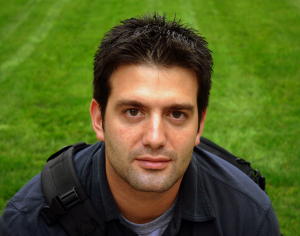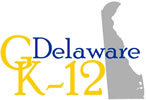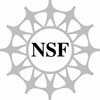| |
| [Home] [Fellows] [2008 Fellows] [2007 Fellows] [Jeffrey Spraggins] |

Research: My research focuses on the use of FT-ICR mass spectrometry for the analysis of environmentally significant samples. A Fourier Transform Ion Cyclotron Resonance Mass Spectrometer (FT-ICR Mass Spec) is an instrument that measures the masses of individual molecules that have been electrically charged to form ions. Although measuring the mass of something is not all that impressive, the ability of this instrument to measure individual ions with extreme accuracy and resolution merits such an intimidating name. In addition, the design of the instrument allows for it to be used as a gas phase beaker where reactions can be observed between ions and molecules in real time.
One example of how we use this powerful technique is our study of the environmentally important reactions between metal clusters and hydrogen sulfide. By monitoring these reactions within the mass spectrometer we have been able to understand more completely the reaction pathways and rates of reaction for cadmium clusters. Currently we are working on systems with iron and zinc metals. Reactions between metal clusters and hydrogen sulfide are important for understanding both the chemistry taking place near hydrothermal vents (geysers on our ocean floors) and the fate of metal pollutants in our natural waterways. |
2007 Teacher Pair: Kevin Madigan_________________Subject: Physical Science
2008 Teacher Pair: Terry Blanch __________________ Subject: Physical Science
Developed Materials
Research Presentation: PPT, PDF ___________Teaching Presentation: PPT, PDF
Website Presentation: PPT, PDF
Lectures
Reading the Periodic Table: PPT, PDF _______________ Atomic Theory: PPT, PDF
States of Matter: PPT, PDF ________________________ State Changes: PPT, PDF
Atomic Inventory: PPT, PDF _________________________ Chem Cubes: PPT, PDF
Natural Resources: PPT, PDF ______________ Chemical Bonding Game: PPT, PDF
HONC if you like Molecules: PPT, PDF _____ ______ The Periodic Table: PPT, PDF
Frayer Models: PPT, PDF ____________________ The Periodic Table v2: PPT, PDF
Activities______________________________________________
Hydrothermal Vent Activity v1: Underwater Volcanoes
Hydrothermal Vent Activity v2: Discovery of a New Ecosystem
Hydrothermal Vent Activity v3: Discovery of a New Ecosystem 2
Presentations
2009 NSF GK-12 Projects Annual Meeting, Washington D.C.
"Special Interest Session: Putting PBL in Your GK-12"
Presentation: PPT, PDF
2009 NSF GK-12 Projects Annual Meeting, Washington D.C.
"Understanding Hydrothermal Vents: Ions, Energy Transfer and Graduate Research"
Poster: PDF
2008 Lilly East Conference on College and University Teaching, University of Delaware,
Newark, DE
"Introducing Science Students to Cutting Edge Research through PBL Activities."
Poster: PDF
|
|
In the classroom: Although I enjoy research, teaching is my true passion. I have a couple fundamental beliefs that drive my teaching philosophy. I believe that {1} any student, if motivated, can learn (and enjoy) science and {2} there should be no separation between what is taught in the classroom and the research that we, as scientists, focus so much of our time and effort working on.
Working with Terry Blanch (St. Georges 2008-2009) and Kevin Madigan (Delcastle 2007-2008) we have worked to develop a series of activities that aim to not only introduce our students to some of the cutting edge research done at the University of Delaware, but also aspire to motivate by highlighting the applicability of what they are learning during 9th Grade Physical Science. We have used what I have learned about hydrothermal vents though my graduate research to develop Problem Based Learning (PBL) activities that include web quests and a qualitative analysis lab (See Underwater Volcanoes & Discovery of a New Ecosystem).

